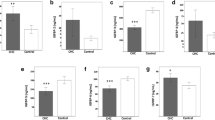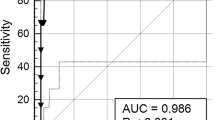Abstract
Information about the stage of liver fibrosis is important for managing patients with chronic hepatitis C (CHC). The aim of this study was to evaluate 12 plasma markers for differentiating no/mild liver fibrosis from cirrhosis among patients with CHC genotype 1. Transient elastography was used to assess the stage of fibrosis for the patients included in the study. Forty patients were included (21 cirrhotic). Plasma levels of tumor necrosis factor-α (TNF-α), interleukin 8 (IL-8), interferon-γ inducible protein-10 (IP-10), monocyte chemotactic protein-1 (MCP-1), soluble urokinase-type plasminogen activator (suPAR), monokine induced by γ-interferon (MIG), human hepatocyte growth factor (HGF), insulin, interleukin 6 (IL-6), interleukin 1-β (IL-1β), leptin, and nerve growth factor (NGF) were analyzed. Concentrations of TNF-α (median 15.0 vs. 25.1 pg/ml, area under the receiver operating characteristic curve [AUC] 0.91), IL-8 (48.7 vs. 103.3 pg/ml, AUC 0.85), IP-10 (176 vs. 566 pg/ml, AUC 0.83), MCP-1 (449 vs. 735 pg/ml, AUC 0.78), suPAR (3.5 vs. 5.2 ng/ml, AUC 0.78), MIG (100 vs. 152 pg/ml, AUC 0.75), and HGF (3.69 vs. 5.58 ng/ml, AUC 0.71) were significantly higher in patients with cirrhosis. In conclusion, several of the investigated markers showed promise for differentiating cirrhosis from no/mild fibrosis among patients with CHC genotype 1.


Similar content being viewed by others

References
World Health Organization (WHO) (2000) Hepatitis C fact sheet. Available online at: https://apps.who.int/inf-fs/en/fact164.html
Strader DB, Wright T, Thomas DL, Seeff LB; American Association for the Study of Liver Diseases (2004) AASLD Practice Guideline: diagnosis, management, and treatment of hepatitis C. Hepatology 39:1147–1171
Van Thiel DH, Gavaler JS, Wright H, Tzakis A (1993) Liver biopsy. Its safety and complications as seen at a liver transplant center. Transplantation 55:1087–1090
McGill DB, Rakela J, Zinsmeister AR, Ott BJ (1990) A 21-year experience with major hemorrhage after percutaneous liver biopsy. Gastroenterology 99:396–400
Ganne-Carrié N, Ziol M, de Lédinghen V, Douvin C, Marcellin P, Castéra L et al (2006) Accuracy of liver stiffness measurement for the diagnosis of cirrhosis in patients with chronic liver diseases. Hepatology 44:1511–1517
Foucher J, Chanteloup E, Vergniol J, Castéra L, Le Bail B, Adhoute X et al (2006) Diagnosis of cirrhosis by transient elastography (FibroScan): a prospective study. Gut 55:403–408
Friedrich-Rust M, Ong M-F, Martens S, Sarrazin C, Bojunga J, Zeuzem S et al (2008) Performance of transient elastography for the staging of liver fibrosis: a meta-analysis. Gastroenterology 134:960–974
Ziol M, Handra-Luca A, Kettaneh A, Christidis C, Mal F, Kazemi F et al (2005) Noninvasive assessment of liver fibrosis by measurement of stiffness in patients with chronic hepatitis C. Hepatology 41:48–54
Zeremski M, Petrovic LM, Talal AH (2007) The role of chemokines as inflammatory mediators in chronic hepatitis C virus infection. J Viral Hepat 14:675–687
Neuman MG, Benhamou JP, Marcellin P, Valla D, Malkiewicz IM, Katz GG et al (2007) Cytokine—chemokine and apoptotic signatures in patients with hepatitis C. Transl Res 149:126–136
Asselah T, Bièche I, Laurendeau I, Paradis V, Vidaud D, Degott C et al (2005) Liver gene expression signature of mild fibrosis in patients with chronic hepatitis C. Gastroenterology 129:2064–2075
Zeremski M, Dimova R, Brown Q, Jacobson IM, Markatou M, Talal AH (2009) Peripheral CXCR3-associated chemokines as biomarkers of fibrosis in chronic hepatitis C virus infection. J Infect Dis 200:1774–1780
Moura AS, Carmo RA, Teixeira AL, Leite VHR, Rocha MOC (2010) Soluble inflammatory markers as predictors of liver histological changes in patients with chronic hepatitis C virus infection. Eur J Clin Microbiol Infect Dis 29:1153–1161
Hanley JA, McNeil BJ (1983) A method of comparing the areas under receiver operating characteristic curves derived from the same cases. Radiology 148:839–843
Mühlbauer M, Bosserhoff AK, Hartmann A, Thasler WE, Weiss TS, Herfarth H et al (2003) A novel MCP-1 gene polymorphism is associated with hepatic MCP-1 expression and severity of HCV-related liver disease. Gastroenterology 125:1085–1093
Hellier S, Frodsham AJ, Hennig BJ, Klenerman P, Knapp S, Ramaley P et al (2003) Association of genetic variants of the chemokine receptor CCR5 and its ligands, RANTES and MCP-2, with outcome of HCV infection. Hepatology 38:1468–1476
Neuman MG, Benhamou JP, Bourliere M, Ibrahim A, Malkiewicz I, Asselah T et al (2002) Serum tumour necrosis factor-alpha and transforming growth factor-beta levels in chronic hepatitis C patients are immunomodulated by therapy. Cytokine 17:108–117
Zylberberg H, Rimaniol AC, Pol S, Masson A, De Groote D, Berthelot P et al (1999) Soluble tumor necrosis factor receptors in chronic hepatitis C: a correlation with histological fibrosis and activity. J Hepatol 30:185–191
Neuman MG, Benhamou JP, Malkiewicz IM, Ibrahim A, Valla DC, Martinot-Peignoux M et al (2002) Kinetics of serum cytokines reflect changes in the severity of chronic hepatitis C presenting minimal fibrosis. J Viral Hepat 9:134–140
Ren Y, Poon RT, Tsui HT, Chen WH, Li Z, Lau C et Al (2003) Interleukin-8 serum levels in patients with hepatocellular carcinoma: correlations with clinicopathological features and prognosis. Clin Cancer Res 9:5996–6001
Akiba J, Yano H, Ogasawara S, Higaki K, Kojiro M (2001) Expression and function of interleukin-8 in human hepatocellular carcinoma. Int J Oncol 18:257–264
Yamagami H, Moriyama M, Tanaka N, Arakawa Y (2001) Detection of serum and intrahepatic human hepatocyte growth factor in patients with type C liver diseases. Intervirology 44:36–42
Eugen-Olsen J, Andersen O, Linneberg A, Ladelund S, Hansen TW, Langkilde A et al (2010) Circulating soluble urokinase plasminogen activator receptor predicts cancer, cardiovascular disease, diabetes and mortality in the general population. J Intern Med 268:296–308
Wai CT, Greenson JK, Fontana RJ, Kalbfleisch JD, Marrero JA, Conjeevaram HS et al (2003) A simple noninvasive index can predict both significant fibrosis and cirrhosis in patients with chronic hepatitis C. Hepatology 38:518–526
Imbert-Bismut F, Ratziu V, Pieroni L, Charlotte F, Benhamou Y, Poynard T et al (2001) Biochemical markers of liver fibrosis in patients with hepatitis C virus infection: a prospective study. Lancet 357:1069–1075
Forns X, Ampurdanès S, Llovet JM, Aponte J, Quintó L, Martínez-Bauer E et al (2002) Identification of chronic hepatitis C patients without hepatic fibrosis by a simple predictive model. Hepatology 36:986–992
Sagir A, Erhardt A, Schmitt M, Häussinger D (2008) Transient elastography is unreliable for detection of cirrhosis in patients with acute liver damage. Hepatology 47:592–595
Arena U, Vizzutti F, Corti G, Ambu S, Stasi C, Bresci S et al (2008) Acute viral hepatitis increases liver stiffness values measured by transient elastography. Hepatology 47:380–384
Reiberger T, Aberle JH, Kundi M, Kohrgruber N, Rieger A, Gangl A et al (2008) IP-10 correlates with hepatitis C viral load, hepatic inflammation and fibrosis and predicts hepatitis C virus relapse or non-response in HIV–HCV coinfection. Antivir Ther 13:969–976
Falconer K, Askarieh G, Weis N, Hellstrand K, Alaeus A, Lagging M (2010) IP-10 predicts the first phase decline of HCV RNA and overall viral response to therapy in patients co-infected with chronic hepatitis C virus infection and HIV. Scand J Infect Dis 42:896–901
Romero AI, Lagging M, Westin J, Dhillon AP, Dustin LB, Pawlotsky J-M et al (2006) Interferon (IFN)-gamma-inducible protein-10: association with histological results, viral kinetics, and outcome during treatment with pegylated IFN-alpha 2a and ribavirin for chronic hepatitis C virus infection. J Infect Dis 194:895–903
Lagging M, Romero AI, Westin J, Norkrans G, Dhillon AP, Pawlotsky J-P et al (2006) IP-10 predicts viral response and therapeutic outcome in difficult-to-treat patients with HCV genotype 1 infection. Hepatology 44:1617–1625
Acknowledgments
We thank Professor, DMSci, Jens Ole Nielsen for the study framework and valuable advice, and biostatistician Steen Ladelund for the important assistance with the statistical analyses. This study was supported by the “A. P. Møller Foundation for the Advancement of Medical Science” (grant support to Nina Weis).
Potential conflicts of interest
Belinda Klemmensen Moessner has received an unrestricted research grant from Roche A/S. Peer Brehm Christensen is a member of the advisory board for Roche A/S and has received research grants from Roche and Schering-Plough A/S. Roche A/S provided the FibroScan device used in this study. Jesper Eugen-Olsen is a founder and board member of ViroGates A/S.
Author information
Authors and Affiliations
Corresponding author
Rights and permissions
About this article
Cite this article
Andersen, E.S., Ruhwald, M., Moessner, B. et al. Twelve potential fibrosis markers to differentiate mild liver fibrosis from cirrhosis in patients infected with chronic hepatitis C genotype 1. Eur J Clin Microbiol Infect Dis 30, 761–766 (2011). https://doi.org/10.1007/s10096-010-1149-y
Received:
Accepted:
Published:
Issue Date:
DOI: https://doi.org/10.1007/s10096-010-1149-y



